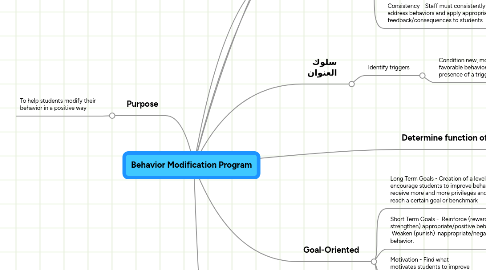Behavior Modification Program
par Jonathan Clark


1. Purpose
1.1. To help students modify their behavior in a positive way
2. ABC - Antecedent, Behavior, Consequence
3. Defining problem behavior - Discover a baseline collection of data
4. Determine function of behavior
4.1. Replace unwanted behavior with a more appropriate alternative
5. Characteristics
5.1. Develop the Least Restrictive Environment
5.2. Principles of Learning: Operant Conditioning
5.3. Research/evidence-based techniques
5.4. Accountability - Students need to "own" their behavior. Students must understand cause/effect
5.5. Consistency - Staff must consistently address behaviors and apply appropriate feedback/consequences to students
6. Goal-Oriented
6.1. Long Term Goals - Creation of a level-system to encourage students to improve behavior. Students receive more and more privileges and rewards when they reach a certain goal or benchmark
6.2. Short Term Goals - Reinforce (reward, strengthen) appropriate/positive behavior. Weaken (punish) inappropriate/negative behavior.
6.3. Motivation - Find what motivates students to improve behavior
6.4. Positive Expectations - Staff needs to display positive expectations and expect students to reach their goals. Students must believe in themselves: Staff must exemplify this characteristic
7. Understand Behavior
7.1. Functional Behavior Assessment
8. The Supportive Teacher
8.1. Calm, not overly emotional
8.2. Caring, compassionate, empathetic
8.3. Consistent
8.4. Overt expectations of success
9. سلوك العنوان
9.1. Identify triggers
9.1.1. Condition new, more favorable behaviors in the presence of a trigger
